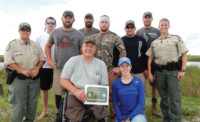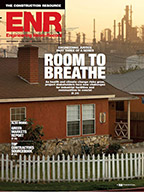Choosing an appropriate project delivery method can be one of the best ways to boost collaboration and productivity. That’s why this team of top young professionals believes that owners and investors need a little schooling on the subject.
“When folks come in and do not understand the construction piece, they push the risk as far as possible downstream,” says Chad Frampton, president and CEO of general contractor Frampton Construction. “The first time something goes wrong, they pull a lever and then you’re talking about default, about liquidated damages and things that put a black eye on the project.”
The group says public agencies need to better understand how alternative project delivery approaches such as design-build, integrated project delivery, advanced work packaging and workface planning allocate risk and align incentives among project team members.
Sofia Berger, senior vice president at Louis Berger, a WSP company, decries the lack of standardization among federal, state and local project procurement rules for alternative project delivery. “These [project delivery methods] are complicated, and you need to train people in the pros and the cons,” she says.
Team Productivity
Sofia Berger
Senior Vice President, Louis Berger, a WSP company
New York City
Brian Ross
Managing Principal & Owner, Ross Infrastructure Development LLC; Founder, InfraShares.com.
San Francisco
Chad Frampton
President & CEO, Frampton Construction.
Ladson, S.C.
Erin Threet
Assistant Vice President, Herbert, Rowland & Grubic Inc.
Lewisburg, Pa.
Danielle Dy Buncio
Co-Founder/CEO, VIATechnik
Chicago
A clearinghouse at the federal level could help owners “compare [methods] against each other and make an informed, risk-weighted decision about which method they’re going to use,” says Brian Ross, managing principal and owner of San Francisco-based Ross Infrastructure Development LLC, which provides finance and project delivery consulting services.
Ross, who also co-founded InfraShares, a crowdfunding platform that helps raise private investment for infrastructure, says there’s not a “uniform understanding of how to structure” public-private partnerships, “or more fundamentally, how to evaluate whether or not P3 is a good decision for your specific project or your specific agency.”
Productivity is also hampered by chronic workforce shortages.
The group says the design and construction industry needs a broader branding effort to attract the next generation of craftworkers, just as milk processing and dairy farming industries launched the famous Got Milk? advertising campaign in the early 1990s to encourage milk consumption.
“Our industry has a marketing problem,” says Danielle Dy Buncio, co-founder and CEO of Chicago-based technology firm VIATechnik.
Noting “it’s not the dirty industry that it was in previous years,” she points to innovations and technologies such as off-site construction and robotic wearables that make jobsites safer, cleaner and more appealing work environments.
“We could use those sorts of things as leverage when marketing,” she says.
Meanwhile, Berger says the U.S.industry should energize prospective employees about construction’s career potential by creating a “prestige” around engineering and other fields the same way other countries place engineers on a pedestal with doctors and lawyers.
She says: “Workers need to want to come to us instead of Silicon Valley and that’s really a struggle.”
One solution is to recruit students focused on disciplines beyond traditional construction pipelines such as computer science, data science, mechanical engineering and robotics.
Frampton says his firm hires “really intelligent folks” without construction or engineering backgrounds because “we feel like we can teach them [construction] if they have a good work ethic.”
Highlighting the trend “toward blending manual labor and robotics, science and technology” is a good way to attract craftworkers, says Ross. He says working in the field is no longer about “how much you can shovel but rather how much you can understand what’s going on at a site and leverage new technologies that are coming into the field.”
Ross adds, “That message needs to be communicated more and started as early as possible … to make sure kids understand it’s not a dichotomy between civil engineering and digging ditches.” He says increasing the craftworker pool could also mitigate the outsourcing of manufacturing jobs abroad.
“Skilled labor should be at the core of the U.S. economy moving forward because you can’t offshore that,” he says, noting that the issue is not just critical “for the construction industry, but for the U.S. broadly speaking.”
Making It All Work
“These [project delivery methods] are complicated, and you need to train people in the pros and cons.”
– Sofia Berger
According to Erin Threet, assistant vice president of design firm Herbert, Rowland & Grubic Inc., a broadscale marketing campaign should also capture the public’s imagination in a way that educates people about how utilities and infrastructure work “because there are people doing what we do, making it all work.”
She also points out that “the kind of things we do … isn’t at the front of the general public’s mind,” so jobs in the many construction industry careers aren’t thought of as No. 1 career options.
While an inevitable economic downturn will further hurt the industry’s workforce, a recession could be just what’s needed to force owners to use alternative delivery methods, according to one young professional.
“Nobody needs to change the project delivery methods, nobody needs to build smarter because everybody’s doing really well; there’s more than enough work to go around,” Dy Buncio says.
While a recession is painful, the technology entrepreneur notes that “a lot of good can come from it. In some ways it could be an exciting time for the industry.”
Backstory
Sofia Berger has also worked for McKinsey & Co. and Perini Corp.
Brian Ross is writing a screenplay about his U.S. Army experiences.
Chad Frampton married his high school sweetheart and has hunted Canada waterfowl.
Erin Threet was president of the Bucknell University Women’s Rugby Football Club and played forward.
Danielle Dy Buncio is a third-generation civil engineer and has rafted Class V white water and scuba dived on three continents despite not knowing how to swim.








Post a comment to this article
Report Abusive Comment